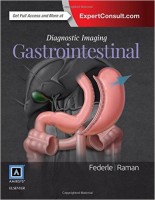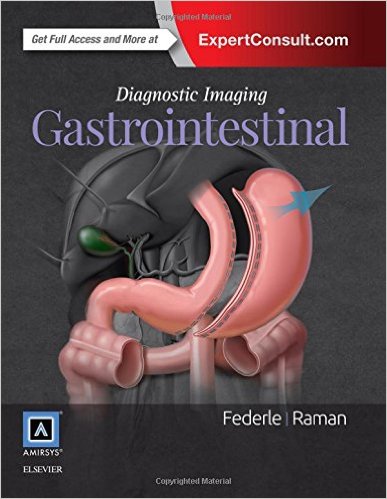 Editors: Michael P. Federle, MD; and Siva P. Raman, MD
Editors: Michael P. Federle, MD; and Siva P. Raman, MD
Contributing Authors: Amir A. Borhani, MD; Mitchell Tublin, MD; R.Brooke Jeffrey, MD
Publisher: Elsevier / Amirsys – 1,071 pages
Book Review by: Hiro Motiram
This book contains primarily, bullet-point text along with a large number of diagnostic images of organs and systems along the gastrointestinal (GI) tract. Amirsys books typically follow this bulleted format, which enables the user (practitioner or student) to learn the material much more quickly than using the much longer, traditional text model with hundreds of thousands of paragraphs in a book of this length.
Use of this format has enabled the editors to cover many, many topics with just short descriptions. If the usual text model were used, this book might have comprised two or even three volumes. Looking at the eight-pages-long Table of Contents, we find that 1,068 different topics and subtopics are covered in this book of 1,071 pages. The pages of the Index are not numbered.
The entire contents of this large book is divided into 11 Sections, each one covering one or several components of the GI system, with the exception of Section I. We list the Sections below to give you an overview of its coverage:
- Abdominal Manifestations of Systemic Conditions
- Peritoneum, Mesentery, and Abdominal Wall
- Esophagus
- Stomach
- Duodenum
- Small Intestine
- Colon
- Spleen
- Liver
- Biliary System
- Pancreas
All the content of this printed book can be viewed online by you, the purchasers. You can activate the eBook version of this title at no extra charge, and view it on the screens of almost any Internet-enabled device, anytime, and anywhere.
Expert Consult eBooks give you the power to browse and find content, view enhanced images, and share notes and highlights – both online and offline.
To unlock your eBook:
- Visit www.expertconsult.inkling.com/redeem
- Scratch off the code on the inside front cover your book
- Type code into Enter Code box
- Click Redeem
- Log In or Sign Up
- Go to My Library
For technical assistance, email: [email protected], call 1-800-401-9962 in the United States, or 1-313-447-8200 outside the U.S.
There are no chapters in this book. Instead, it contains a large number of topics and subtopics. Within the 11 Sections we have listed above, you will typically find these clinical aspects (with some exceptions and variations) of the organ system covered, as shown in Section 3, Esophagus:
- Introduction and Overview
- Infection
- Inflammation
- Degenerative
- Vascular Disorders
- Esophageal Diverticula
- Trauma
- Treatment-Related
- Benign Neoplasms
- Malignant Neoplasms
When you go into reading about a particular topic, you will find at the beginning of the page a box named Key Facts with a number of headings and subheadings. For example, when you go to Section 7 on Colon, then look at the topic Infectious Colitis, you will find the following headings in the Key Facts box:
- Terminology – with one bullet point
- Imaging – with three bullet points
- Top Differential Diagnoses – with three bullet points
- Clinical Issues – with six bullet points
When you go to the next Key Facts box entitled Ulcerative Colitis, you will find the same four headings as we list above, plus two others: Pathology and Diagnostic Checklist.
So as you can see, the editors are utilizing the same well-thought-out system of presentation of facts and points for you to use, when you’re diagnosing and treating patients with different problems related to the gastrointestinal tract.
Among the benefits of using this book are the following:
- Expanded coverage of the most important topics and trends in the fluoroscopic evaluation of the gastrointestinal tract, including evaluation of patients before and after bariatric surgery, fundoplication, and surgery for esophageal carcinoma.
- Updated sections covering disorders of the liver, biliary tract, and pancreas with information and images regarding new classification treatment implications for pancreatitis, including autoimmune (lgG4-related) pancreatitis
- Increased number of illustrations of all appropriate modalities, such as multiplanar CT, sonography, MR, and PET/CT
- Current information on all forms of acute and chronic hepatitis and cirrhosis, as well as critical knowledge regarding imaging techniques that allow radiologists to distinguish among focal lesions in the cirrhotic liver
- Expert Consult eBook version included with purchase allows you to search all of the text, figures, and references from the book on a variety of devices.
This book is an outstanding product because of this excellent feature: it’s very user-friendly because it gives you – the busy and established practitioner, resident, or student – the essential information needed to diagnose the ailment, condition, disease, or disorder in the patient, and formulate a treatment plan, which may consist of a combination of activity-based, nutritional, pharmacologic, or surgical solutions.
Editors:
Michael P. Federle, MD is Professor and Associate Chair for Education in the Department of Radiology at Stanford University Medical Center in Stamford, California.
Siva P. Raman, MD is Associate Professor of Radiology at Johns Hopkins University School of Medicine in Baltimore, Maryland.
Contributing Authors:
Amir A. Borhani, MD is Assistant Professor of Radiology at the University of Pittsburgh School of Medicine in Pittsburgh, Pennsylvania.
Mitchell Tublin, MD is Professor and Vice Chairman, Chief of Abdominal Imaging in the Department of Radiology at the University of Pittsburgh School of Medicine in Pittsburgh, Pennsylvania.
R. Brooke Jeffrey, MD is Professor and Vice Chairman of the Department of Radiology at Stanford University Medical Center in Stamford, California.
Text Editors:
David L. Chance, MA, ELS; Arthur G. Gelsinger, MA; Nina I. Bennett, BA; Sarah J. Connor, BA; Tricia L. Cannon, BA; Terry W. Ferrell, MS; and Lisa A. Gervais, BS.
Image Editors:
Jeffrey J. Marmorstone, BS; and Lisa A.M. Steadman, BS
Medical Editor:
Michael Sacerdote, MD
Illustrators:
Richard Coombs, MS; Lane R. Bennion, MS; and Laura C. Sesto, MA
Art Directors and Designers:
Tom M. Olson, BA; and Laura C. Sesto, MA
Lead Editor:
Sarah J. Connor, BA
Production Coordinators:
Angela M. Terry, BA; and Rebecca L. Hutchinson, BA







